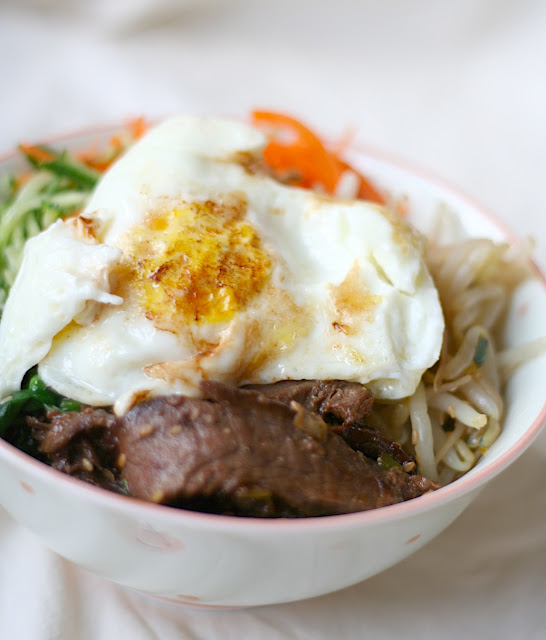See, when I was a kid, we lived close to a steak house. And I loved steak. So I would get a big steak and gorge myself. My mom, on the other hand, would always ALWAYS get the bi bim bop. And she always made the better choice. I pretty much always regretted my decision.
But years of going to Korean restaurants and being disappointed with really bland bi bim bop, I finally decided to roll up my sleeves and get to work on reliving my childhood memory of the dish sitting in front of my mom instead of myself that I always coveted. And I think I did it. It's full of flavor and textures and temperatures that just work so well together. It's a little labor intensive, but so worth the effort. Really. You gotta try it out.
Bi Bim Bop
serves 4
4 portions of cooked short grain rice
4 eggs
2~3 carrots, grated (lengthwise)
4 mini cucumbers, grated (lengthwise)
for the spinach:
1/2 lb baby spinach leaves, washed and dried
1/2 tablespoon sugar
1/2 tablespoon soy sauce
for the bean sprouts:
1 lb mung bean sprouts or soy bean sprouts
1 tablespoon soy sauce
1 tablespoon sesame oil
1 clove of garlic, grated
2 teaspoons sugar
for the beef: (bulgogi)
1 lb flank steak (is my favorite cut of meat for this, but you can definitely use something richer like ribeye or sirloin), frozen until mostly frozen, about half an hour, then sliced super thin, diagonally, against the grain
3 tablespoons sugar
1/4 cup to 1/2 cup soy sauce
2 cloves garlic, crushed
3 scallions, minced
5 tablespoons mirin
2 tablespoons sesame oil
2 tablespoons toasted, crushed sesame seeds
- For the beef: Combine all of the marinade for the beef together in a bowl until sugar is mostly dissolved. Add beef and let marinate for at least 10 minutes. Preheat a well oiled skillet or grill to high heat and cook the beef slices in a single layer in batches, making sure they get a good sear instead of steaming. Repeat with all batches, set aside.
- For the spinach: In a medium saucepan, bring about a 1/2 cup of lightly salted water to a simmer. Add the spinach, place the lid on top, and let steam for just a couple of minutes until the spinach wilts. Drain immediately and squeeze out as much excess liquid as you can. Add the sugar and soy sauce and toss to combine.
- For the bean sprouts: In a medium bowl, combine the soy sauce, sesame oil, garlic, and sugar until thoroughly encorporated. Fill a medium saucepan about halfway with water and bring to a boil. Add bean sprouts and let cook until slightly translucent but still crisp, about 2 minutes. Immediately drain and add to the bowl with soy sauce mixture. Toss to thoroughly combine.
- For the eggs: Either fry them over easy/over medium or scramble them and cook in a thin layer. Once the egg "pancake" is cooked and slightly cooled, slice thin to serve.
- To serve: Place one portion of rice in a medium serving bowl. Top with beef, bean sprouts, spinach, cucumber, and carrots in a circle. Top with the fried egg. (If making a scrambled egg pancake, put the egg in the surround circle and top with beef slices) Serve with kimchee and sriracha sauce.


















